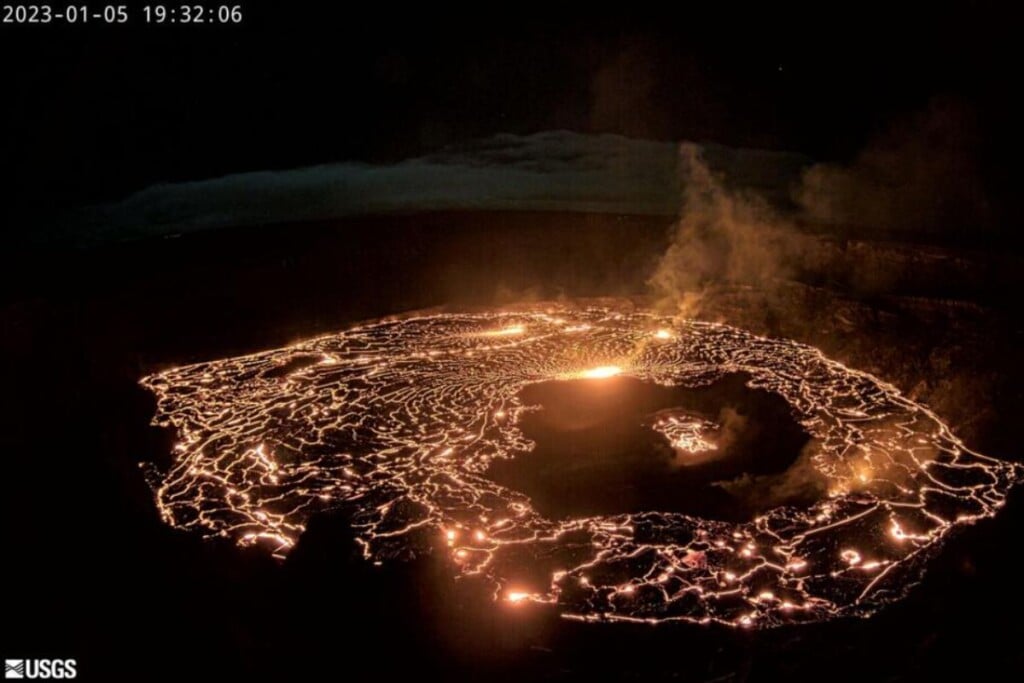Kīlauea Eruption Resumes—UPDATED
Lava returns to Halemaʻumaʻu crater after a nearly month-long pause.

Updated Monday, Jan. 9 at 10 a.m.
On Jan. 5, Kīlauea resumed erupting within Halemaʻumaʻu after pausing on Dec. 9, 2022. All eruptive activity has been confined to the crater.
KĪLAUEA DAILY UPDATE
Sun., Jan. 8, 2023, 7:45 AM HSTEruption of lava from vents in the east-central portion of Halemaʻumaʻu crater floor continued; active lava area in the eastern half of the crater shrank slightly in the past 24 hours.
Beautiful sunrise views this morning… pic.twitter.com/dEJN76gSRw
— USGS Volcanoes🌋 (@USGSVolcanoes) January 8, 2023
Lava is visible from multiple areas overlooking the caldera and the new eruption of Kīlauea is drawing thousands of visitors to Hawaiʻi Volcanoes National Park. Visitors should head to the national park’s website for tips how to see the eruption as well as how to stay safe and help protect the park.
Updated Thursday, Jan. 5 at 8 p.m.
There is once again an erupting volcano on Hawaiʻi Island.
Kīlauea resumed erupting within Halemaʻumaʻu after pausing on Dec. 9, 2022.
According to the Hawaiian Volcano Observatory, the eruption began around 4:30 p.m. on Jan. 5. A fissure opened and scientists detected a glow within Kīlauea’s summit caldera. Then at around 5:45 p.m., a new vent opened in the central-eastern part of the crater.
Sizable bright orange lava fountain and fast moving flows visible during the first hour of the eruption from the Keanakākoʻi overlook. NPS video/Janice Wei pic.twitter.com/ThMxKEEcY4
— Hawaii Volcanoes NPS (@Volcanoes_NPS) January 6, 2023
Kīlauea had made headlines when it began erupting on Sept. 29, 2021. It produced a lava lake that could be seen from within Hawaiʻi Volcanoes National Park. Geologists, professional photographers, amateur volcanologists and visitors all flocked to see the mesmerizing glow from the lava. Some also made the journey to make offerings to Pele, the Hawaiian volcano goddess.
But more recently, Kīlauea wasn’t the only volcano erupting on the Big Island. After 38 years, Mauna Loa, the world’s largest active volcano, began erupting on Nov. 27, 2022. Thousands headed to Daniel K. Inouye Highway, commonly called Saddle Road, to see the lava flow from fissure 3 move down the volcano. Some were lucky enough to see both Kīlauea and Mauna Loa from a vantage point in the national park.
Less than two weeks later, Kīlauea’s eruption halted on Dec. 9, 2022. It was just one day before Mauna Loa’s historic eruption ended.
As Kīlauea begins to awaken, officials say activity is entirely within Hawaiʻi Volcanoes National Park and does not pose a threat to any residential communities on the Big Island.
View this post on Instagram
Kīlauea’s last eruption produced more than 29 billion gallons of lava into the summit of Halemaʻumaʻu. According to officials, the magnitude of lava raised the floor by nearly 460 feet.
Officials from Hawaiʻi Volcanoes National Park say lava is currently visible from several areas and overlooks around the caldera. More information can be found at the park’s website. You can also follow the eruption live from the USGS webcam.


